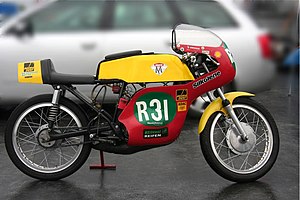Maico 125 RS
 Maico 125 RS 2 |
|
| Manufacturer | Maico |
| Production period | 1968 to 1974 |
| class | Racing motorcycle |
| Motor data | |
| Air-cooled single-cylinder two-stroke engine , rotary valve control, mixture lubrication 1: 15 | |
| Displacement (cm³) | 124 |
| Power (kW / PS ) | up to 25 hp at 11,000 rpm |
| Top speed ( km / h) | over 190 |
| transmission | 6-speed |
| drive | Chain drive |
| Wheelbase (mm) | 1295 |
| Empty weight (kg) | 81 |
The Maico 125 RS was a racing motorcycle from the Maico vehicle factory in Pfäffingen , which was used in motorcycle races from 1968 to 1976. With 146 units sold, the racing motorcycle, which is also fully competitive internationally for private drivers, was the best-selling model in its racing class.
History and technology
The development of the Maico 125 RS goes back to the production model MD 125 SS, which was introduced in 1965 and added to the Maico sales range in 1968. The rotary valve controlled motor developed 14.5 HP . Although company boss Otto Maisch was not interested in racing, an engine conversion kit (Maico 125 RS 1) was developed under chief designer Günther Schier to increase performance, which should also be available for sports drivers. The increased power by 30 mm was achieved Bing - carburettor and modified rotary valve. In 1968 the engine was tested and impressed with an output of 22 hp at 10,000 rpm. As a result, it was decided to build a limited small series of a complete racing motorcycle and from November 1968 customers could order the fully faired Maico 125 RS 2 . The tank and rear bumper were yellow, the full fairing was painted red. The air-cooled motor was built into a double-loop tubular frame, which was cushioned with a Ceriani telescopic fork and two-arm swing arm. Narrow 18- inch tires (2.50 at the front and 2.75 at the rear) made it easy to handle. At the front, the machine had a 180-mm Duplex - drum brake at the rear, a 136-mm simplex brake. In 1970 a six-speed gearbox was developed and in 1971 a revised frame (called "flat wheel" in the factory) was offered for the factory machine .
The Maico was widespread among private drivers. In the 1971 Fischereihafen race in Bremerhaven alone, 48 Maicos competed in this displacement class. The German motorcycle road championship , sometimes referred to as the "Maico Cup", was won by Maico drivers in this displacement class from 1970 to 1976. A water- cooled motor ( thermosiphon ) was developed for factory drivers , which was said to have an output of 32 hp at 12,000 rpm. Dieter Braun finished fourth in the 1971 motorcycle world championship with the factory machine in the class up to 125 cc. This season, Börje Jansson finished third in the motorcycle world championship ahead of Dieter Braun and rode the works Maico until the 1973 season . The racing motorcycle was still offered to private drivers in 1973/1974. Peter Frohnmeyer still rode the Maico 125 RS 2 at the 1975 motorcycle world championship and Walter Koschine won the German championship in 1976 on a Maico.
In 1975, the Maico 125 RS 3, a racing motorcycle with a water-cooled engine, contactless ignition system and 34 mm Bing carburetor, was developed with an output of 29 hp at 12,200 rpm; only seven copies were completed. The Maico 125 RS 3 had no chance against international competition with two-cylinder two-stroke engines .
literature
- Frank O. Hrachowy: Maico Motorcycles: History - Types - Technology , Verlag Vennekate, 1st edition, Lemgo 2005, ISBN 978-3-935-51721-8 .
- Erwin Tragatsch : racing motorcycles. Germany. Austria. Switzerland. Motorbuch Verlag Stuttgart, 1st edition 1982, ISBN 3-87943-851-X .


